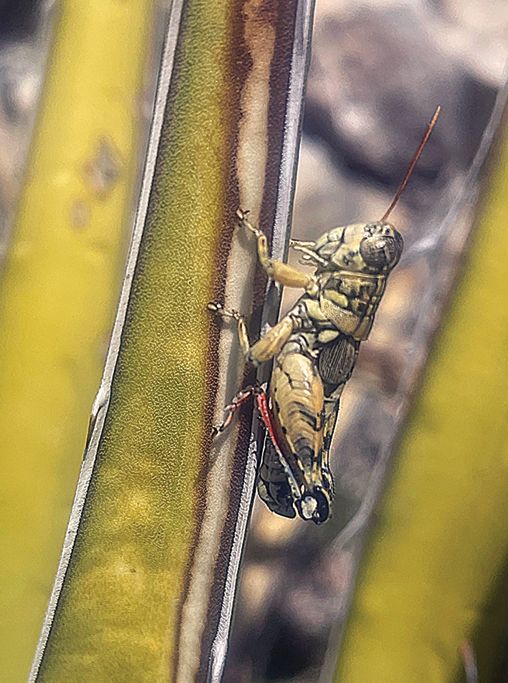Guest blog post by JoVonn Hill
Back in 2018, I began conducting fieldwork on grasshoppers in Texas. Among the specimens I collected that year, I noticed something intriguing—what appeared to be a new species of Agroecotettix. That initial discovery set the stage for years of research, stretching through 2024. During this time, I continued to collect Agroecotettix specimens and studied collections from several institutions, including the Academy of Natural Sciences in Philadelphia, the University of Michigan Museum of Zoology, Brigham Young University, and the Mississippi Entomological Museum.

By analyzing these specimens, I identified 16 new species of Agroecotettix from the United States and Mexico. Interestingly, most of these species are associated with mountainous of Texas and Mexico. Some also inhabit the South Texas Plains ecoregion and the Edwards Plateau.
Habitat and Behavior of Agroecotettix
Agroecotettix grasshoppers are often found on thorny, leguminous shrubs such as Acacia and Vachella. Mesquite is typically not a host. In the Big Bend region of Texas, I often found them on Sotol—sometimes consuming pollen, other times seeking shade beneath the leaves during the heat of the day.

One sweltering day in Big Bend National Park, it was 113°F, and I was trudging through Boquillas Canyon, searching for grasshoppers. After two hours of seeing a couple grasshoppers, I was ready to leave. Then, glancing up, I spotted 40 or 50 grasshoppers clustered on the undersides of Sotol leaves, sheltering from the mid-day sun. Many of them were Agroecotettix, alongside other flightless desert grasshoppers like Phaulotettix and Netrosoma. It was just like picking fruit off a tree—no net needed.

Much of what we now know about Agroecotettix species stems from the work of Dr. Theodore Cohn. During the 1950s and 1960s, he conducted extensive fieldwork in Mexico, often in areas that are now too dangerous to access. His collections were invaluable for identifying several of the new species, highlighting the enduring importance of historical specimens and natural history collections.
Naming these species offered a unique opportunity to honor individuals and ideas that have influenced me such as:


- LeVar Burton: One species is named after this the Reading Rainbow and Star Trek icon. Burton is an American treasure who has inspired a love of reading in millions, including me. As a child, I grew up watching Reading Rainbow and later found myself reading those same books to my own kids during school events.


- Ted Turner: Another species honors Ted Turner, the entrepreneur and conservationist. Turner’s efforts to preserve vast swaths of the western U.S. have will have a lasting impact on biodiversity.


- Michael Dorn: Known for playing Worf on Star Trek, Dorn inspired another species name. Work was always my favorite character. A portion of this species anatomy resembled a Klingon weapon, making the connection apt.


- IDIC: One species is named after the Vulcan philosophy of “Infinite Diversity in Infinite Combinations.” This Star Trek principle seemed a fitting name for a species in this group of cryptic species.


- Jay Silverheels: another species honors Silverheels’ cultural impact and the Texas landscapes where the series was set. A Native American athlete and actorwho most famously portrayed the fictional character Tonto in “The Lone Ranger” television series from 1949-1957, Silverheels was one of the first Native American actors to portray a major Indigenous character on a television series. Throughout his career, Silverheels advocated for more inclusion of Indigenous people in media and founded the Indian Actors Workshop in Los Angeles during the 1960’s.


- Clayton Moore: Known for playing the Lone Ranger, “moorei” honors Clayton Moore for his portrayal of this fictional Texas Ranger that embodied justice, bravery, and connection to the American West.


- Frida Kahlo: The species name kahloae patronym the iconic Mexican painter known for her vivid and symbolic artwork. Her enduring connection to Mexican culture makes her an apt figure to be commemorated through this species, which is endemic to Mexico.
Exploring the Agroecotettix genus has been a journey into the unexpected. What began as a few curious specimens turned into the discovery of 16 species (and counting). The biodiversity of this group, particularly in Mexico, is likely even greater than we currently realize.
The natural world never ceases to amaze. Just when you think you’ve seen it all, you look a little closer using new techniques or tools—and suddenly, there’s a universe of diversity waiting to be discovered.
Research article:
Hill JG (2024) Desert diversification: revision of Agroecotettix Bruner, 1908 (Orthoptera, Acrididae, Melanoplinae) with descriptions of sixteen new species from the United States and Mexico. ZooKeys 1218: 177-230. https://doi.org/10.3897/zookeys.1218.133703
















